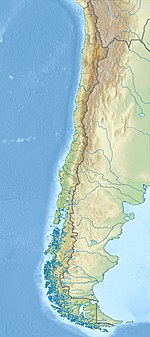Cerro Ascotan
| Cerro Ascotan | |
|---|---|
| del Jardin | |
 Cerro Ascotan seen from Salar de Ascotán | |
| Highest point | |
| Elevation | 5,473 m (17,956 ft)[1] |
| Coordinates | 21°41′S 68°07′W / 21.683°S 68.117°W[2] |
| Geography | |
| Location | Chile / Bolivia |
| Geology | |
| Mountain type | Stratovolcano[1] |
| Last eruption | Pleistocene [1] |
Cerro Ascotan (also known as del Jardin[3]) is a volcano on the border between Chile and Bolivia. It is 5,473 metres (17,956 ft) high,[1] 1,770 metres (5,810 ft) above the terrain and a maximum slope in the summit area of 26°. A breach in the edifice is 1.9 kilometres (1.2 mi) wide and 3.4 kilometres (2.1 mi) long, with an azimuth of 252°.[2] The current snowline lies between 5,700–5,900 metres (18,700–19,400 ft); during the Pleistocene it was lower at 4,900–5,000 metres (16,100–16,400 ft).[4] The volcano's summit, about one third thereof, was removed by a large explosion,[3] with debris thrown at large distances.[5] Volcanic activity probably occurred during the Pleistocene.[1] The volcano is neighbor to Cerro Araral.
References[edit]
- ^ a b c d e "Ascotan". Global Volcanism Program. Smithsonian Institution. Retrieved 16 April 2019.
- ^ a b Francis, P. W.; Wells, G. L. (July 1988). "Landsat Thematic Mapper observations of debris avalanche deposits in the Central Andes". Bulletin of Volcanology. 50 (4): 258–278. Bibcode:1988BVol...50..258F. doi:10.1007/BF01047488. ISSN 1432-0819. S2CID 128824938.
- ^ a b Werner Zeil (1964). Geologie von Chile: Mit 10 Ausklapptafeln, 43 Textabbildungen und 57 abbildungen auf Tafeln (in German). Gebr. Borntraeger. p. 104. ISBN 9783443110031.
- ^ Ram Bali Singh (1 January 1992). Dynamics of Mountain Geosystems. APH Publishing. p. 165. ISBN 978-81-7024-472-1.
- ^ Grove, Lilly (February 1893). "Deserts of Atacama and Tarapaca". Scottish Geographical Magazine. 9 (2): 57–65. doi:10.1080/00369229308732601.
External links[edit]
- Aguilera Banchero, Francisca Sofía (2021). Alteración hidrotermal en superficie en el Volcán Astocán (Norte de Chile): estudio a través de la mineralogía de arcillas y sulfatos (Thesis) (in Spanish).


